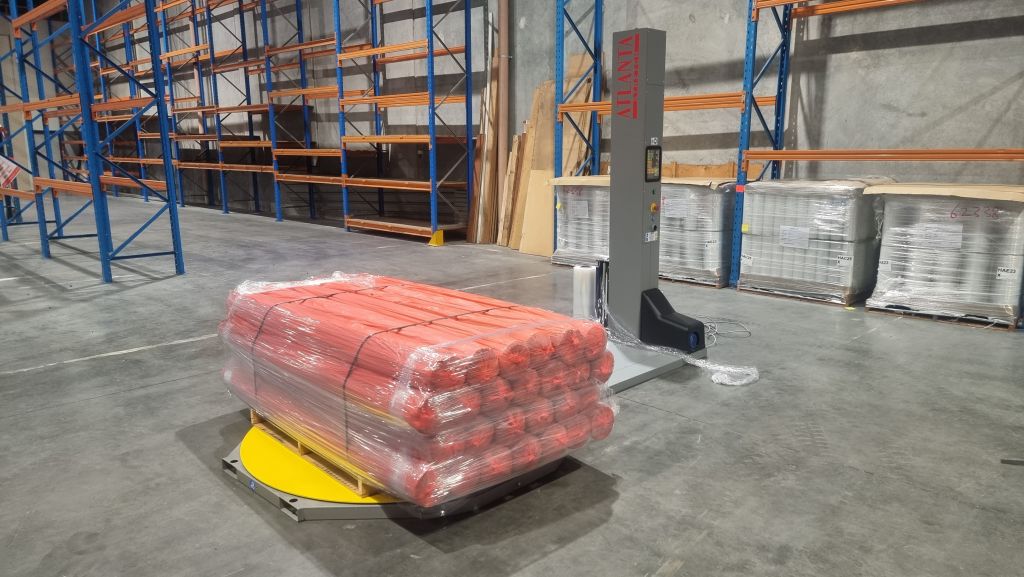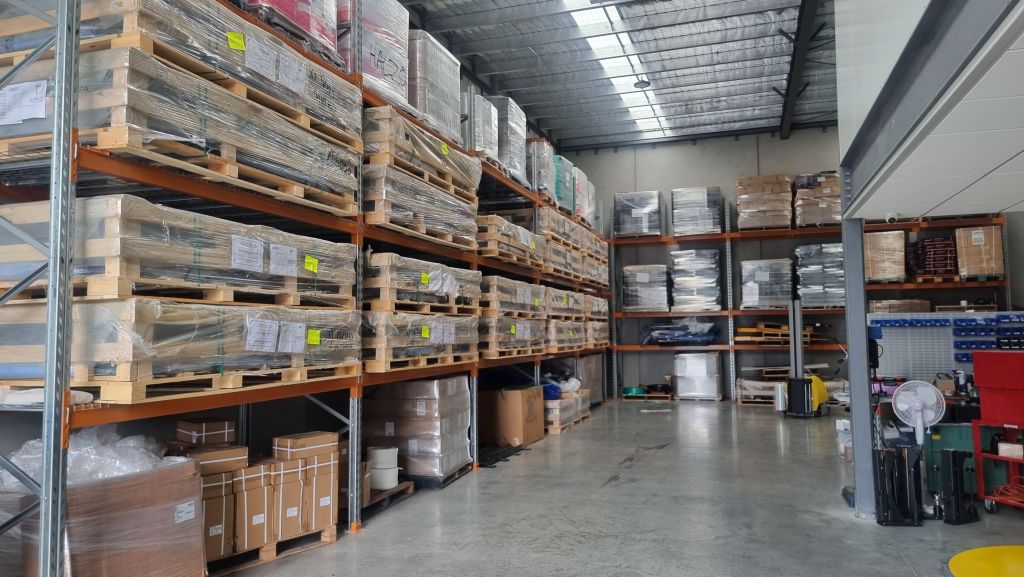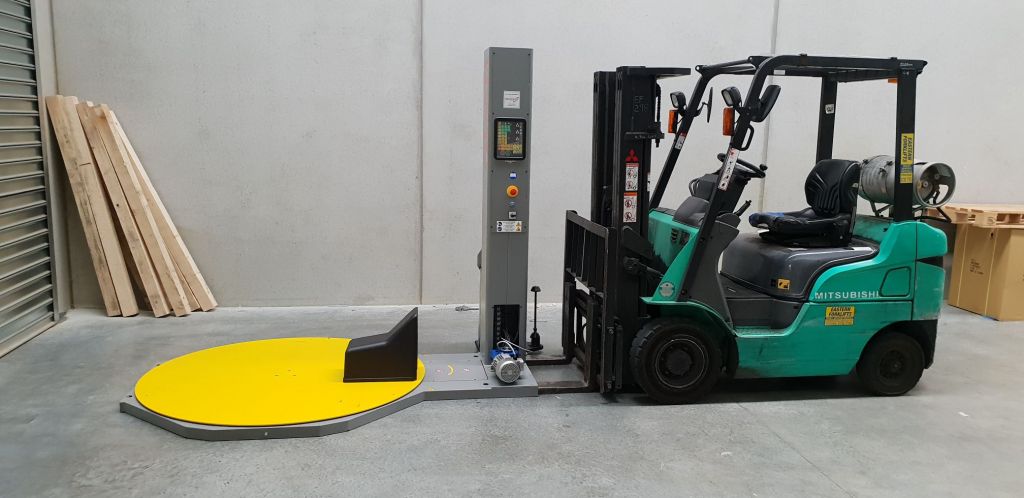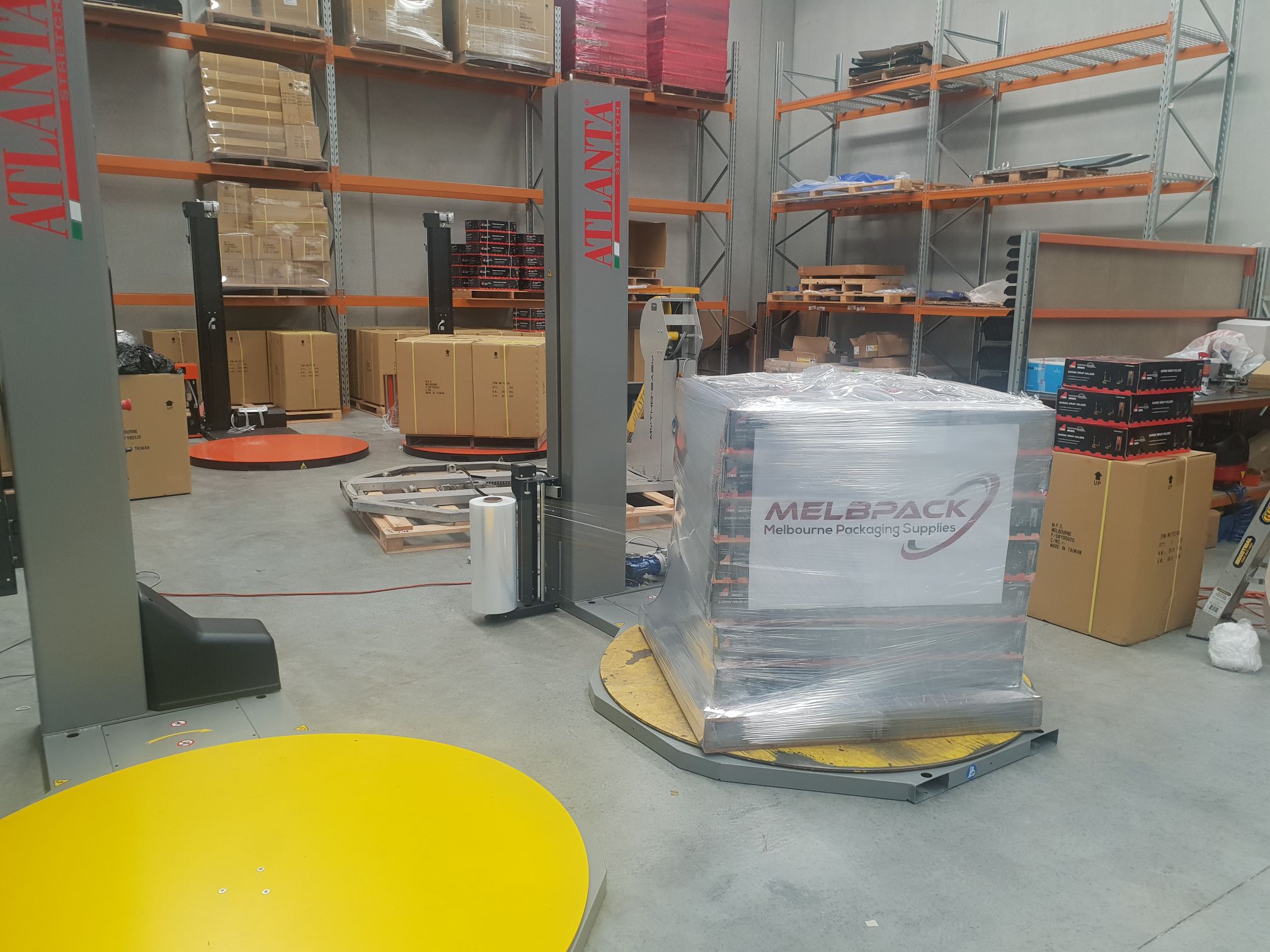If you’re thinking about getting a pallet wrapper for your business operations or potentially upgrading your current one, there are a number of things that should be considered and questions that you should think about to ensure you find the right pallet wrapper for your needs.
During our time in the packaging and logistics equipment and machinery industry, we’ve worked with many different kinds of businesses, each with unique needs, and over that time, we’ve worked out the questions that help us help you find the right pallet wrapper.
Below, we’ve listed these questions and why we ask them so that you can think about these factors before purchasing a pallet wrapper.
Question 1: What are you wrapping?
Why we ask this question:
Understanding what products our customers are wrapping is crucial in recommending the most suitable pallet wrapper. This question helps us gauge the type and nature of the goods – whether they’re heavy or light, bulky, fragile, uniform or irregularly shaped, and so forth.
For instance, if you’re wrapping heavy or irregularly shaped items, you might need a robust pallet wrapper with high-strength film and advanced tension control. On the other hand, if the products are more uniform and lighter, a simpler and more cost-effective model could be sufficient.
Knowing what you’re wrapping also helps us to determine other important factors, such as the type of film best suited for your products, the required wrapping speed, and any additional features that might be necessary, like enhanced load stabilisation for fragile items. Ultimately, this information ensures that the pallet wrapper we recommend aligns perfectly with your specific packaging requirements.
There are a number of load specific questions that we also ask, which are listed below:
- What size pallet do you use?
- Do you have different sized pallets?
- How tall do you stack your products?
- How light or heavy are your pallet loads?
- Do goods overhang your pallets?
- Are your goods sharp or abrasive?
- Are your goods stacked to the corner of your pallets or are they set back from the corners?
These questions can help us determine which pallet wrapper and materials you need. There are so many factors to be considered. The above questions help us with figuring out the following:
- Matching Pallet Wrapper Specifications: Pallet wrappers come with varying turntable sizes and weight capacities and wrap height capabilities. It’s important to choose a machine that can comfortably handle the size of your pallets. For instance, if you use oversized or unusually shaped pallets, you might need a pallet wrapper with a larger turntable or one with an extended base, increasing the distance between the turntable and mast. If your goods are heavy, you need a pallet wrapper that can meet these demands and avoid overloading and damaging your pallet wrapper.
- Ensuring Efficient Wrapping: Properly sized equipment ensures that your pallets are wrapped efficiently and securely. If a pallet wrapper is too small for your pallets, it can lead to ineffective wrapping, potential damage to the wrapper or the goods, and safety risks. Conversely, a machine that’s too large for your needs may result in unnecessary energy use and space occupation. Efficient wrapping is not just about wrapping the products properly but also cost effectively, so knowing whether your pallets are regular, oversized, or unusually shaped can help to determine this.
- Customisation Options: Some businesses use a range of pallet sizes. In such cases, we can explore pallet wrappers with adjustable settings or those that are designed to handle a variety of wrapping settings. This flexibility can be crucial for maintaining efficiency across different types of loads.
- Safety and Stability Considerations: Knowing things like the height, the way your goods are stacked and the types of products is crucial in ensuring safety and stability. You need to be able to move pallets without risk. This can impact the type of machine you use and your wrapping technique.

Question 2: Do you have to weigh your loads, and are you expecting the machine to weigh them?
Why we ask this question?
Understanding whether there is a need to weigh your loads as part of the pallet wrapping process is vital for a couple of reasons. It helps us identify if you require a pallet wrapper with integrated weighing capabilities and understand the broader context of your logistical and operational needs.
There can be various reasons that loads may need to be weighed, including:
- shipping cost calculations
- inventory management
- ensuring compliance with weight regulations for transportation
- quality control purposes.
Knowing your specific reason for weighing helps us recommend a solution that aligns with your operational goals.
Some advanced pallet wrappers come with built-in scales that can weigh the load during the wrapping process. This integration can significantly streamline operations by combining wrapping and weighing into a single step, thereby saving time and reducing the movement of goods.
If weighing is a critical part of your process, integrating it with the pallet wrapping can improve accuracy and operational efficiency. It ensures that every pallet is weighed consistently and accurately, which is crucial for businesses where weight accuracy is a compliance or cost factor.
Question 3: How are you wrapping your loads now?
Why we ask this question?
This question is essential to understand your current packaging process and identify any potential areas for improvement. Knowing how you currently wrap your goods – whether manually, using semi-automatic methods, or with an outdated or inefficient machine – allows us to assess the effectiveness of your existing method and suggest upgrades or changes that could enhance efficiency, reduce costs, or improve safety.
For example, if you’re wrapping pallets manually, you might be facing issues like inconsistent wrapping, higher labour costs, and increased physical strain on workers. In this case, we can demonstrate how a semi-automatic or automatic pallet wrapper could significantly speed up your operations, provide more consistent and secure wrapping, and potentially lower your overall costs.
Alternatively, if you already use a pallet wrapper but it’s an older model, we can explore the benefits of newer, more advanced machines. These might include better film efficiency, faster wrapping speeds, or improved safety features.
Understanding your current method helps us tailor our recommendations to directly address the specific challenges or limitations you’re facing in your packaging process. Our goal is to offer a solution that not only meets but exceeds your packaging needs, enhancing both efficiency and effectiveness.

Question 4: How many pallets or loads are you wrapping on average per day, week, or yearly?
Why we ask this question:
Knowing the volume of pallets or loads you wrap in a given period is a critical factor in selecting the right pallet wrapper for your needs. This information allows us to gauge the capacity and efficiency level required for your operation and recommend a machine that can handle your workload without over or under-utilisation.
If you’re wrapping a small number of pallets daily or weekly, a manual or semi-automatic pallet wrapper might be sufficient. These options are more cost-effective for lower volumes and can adequately meet your needs without unnecessary additional features.
If you’re wrapping a substantial number of pallets, an automatic pallet wrapper may be more appropriate. High-volume operations benefit from the speed, consistency, and labour savings that automatic machines offer. They can significantly streamline your process, reduce the time and labour involved in wrapping, and ensure a consistent and secure wrap every time.
In case your wrapping volume varies significantly (for example, during peak seasons), we can look into flexible solutions that can easily adapt to changing demands.
Additionally, understanding your wrapping volume helps us to assess other aspects like the durability of the machine, the need for features like pre-stretch film capabilities, and the potential for future scalability. Our aim is to provide a solution that not only meets your current demands but also accommodates future growth and changes in your business.
Question 5: Do you ever experience damage when shipping or transporting your goods and do you know the cause?
Why we ask this question:
This question helps us understand if there are any issues with your current wrapping and shipping process that could be addressed with a better pallet wrapping solution. Shipping damage can be costly, not only in terms of product loss or damage but also in affecting customer satisfaction and business reputation.
If you are experiencing shipping damage, identifying the cause is crucial. Is it due to inadequate wrapping strength? Is the damage occurring at the top, bottom, or sides of the pallet? Is the load shifting during transit? Or is it an issue with the way products are being stacked or handled?
Once we know what’s causing the damage, we can recommend a pallet wrapper and the right materials to mitigate these issues.
Question 6: What colour are the goods that your machine sees?
Why we ask this question:
This question might seem unusual at first, but understanding the colour of the goods or the packaging can be important, especially if you’re considering a pallet wrapper with automatic load-height sensing technology. These sensors detect the height of the pallet load to determine where to start and stop the wrapping process.
Some automatic pallet wrappers use photo-eye sensors to detect the height of the pallet load. These sensors can sometimes have difficulty detecting certain colours or reflective surfaces. For example, black or very dark-coloured loads can absorb light, making it harder for standard photo-eyes to detect the top of the load accurately.
If your loads include such colours or materials, we might need to consider a pallet wrapper equipped with a more advanced sensor technology, or manually adjust the sensor settings to ensure accurate detection.

Question 7: What is your method of loading your pallet onto your stretch wrapper?
Why we ask this question:
Understanding the method by which you load pallets onto the wrapper is crucial for recommending the right type of pallet wrapper and ensuring it integrates seamlessly into your workflow. Different loading methods may require different machine designs or configurations. Here’s a general guide that may be helpful:
| Counterbalanced forklift | Standard machine suitable |
| Reach stacker | Standard machine suitable |
| Walkie stacker with reach | Standard machine suitable |
| Manual pallet jack | Standard machine suitable with ramp |
| Combo of above | Requires 1500mm HD ramp or loading of fork and pallet jack at different angles with standard ramp |
| Electric pallet jack (Some work on 1500mm, check clearance) | Requires 2M longramp |
| Is a tugger/pallet mover being used to load? | May require longer than 2m ramp /pit frame / rotating arm |
| Walkie with no reach | Requires lifting kit / pit frame / rotating arm |
By identifying your loading method, we can ensure that the pallet wrapper we recommend not only fits into your physical workspace but also aligns with your operational processes, enhancing efficiency, safety, and overall workflow integration.
Question 8: Are you limited on space?
Why we ask this question:
This question is essential to ensure that the pallet wrapping solution we recommend fits comfortably within your available workspace and aligns with your operational layout.
If your facility has limited space, this can significantly influence the type of pallet wrapper that’s feasible for your operations. In tight spaces, large, stationary wrappers might not be practical. Instead, we might suggest a more compact model or a mobile pallet wrapper that can be moved around as needed.
Understanding your space limitations also helps us recommend a pallet wrapper that integrates smoothly into your existing workflow without causing disruption or requiring major rearrangements.
For businesses with space constraints, optimising the use of available space is key. We can explore pallet wrappers that offer features like a smaller turntable or a vertical mast that requires less horizontal space.
Question 9: Where will the machine be located?
Why we ask this question:
Knowing the location where the pallet wrapper will be installed is crucial for several reasons, as different environments can affect the performance, suitability and the warranty of the machine.
- Warehouse or Indoor Environment: If the machine is to be located in a standard warehouse or indoor setting, most pallet wrappers will function effectively. However, we still consider factors such as floor space, ceiling height, and proximity to other operations to ensure seamless integration.
- Outdoor or Awning Area: If the pallet wrapper is to be located outdoors or under an awning, it needs to be durable enough to withstand weather conditions. We would recommend a machine with robust construction and possibly weatherproofing features to protect it from elements like rain, sun, and dust.
- Cool Room or Freezer Room: In cold environments, such as cool rooms or freezer rooms, the machinery needs to operate effectively at low temperatures. Specialized pallet wrappers are designed for these conditions, with features that prevent the freezing of components and ensure smooth operation in cold environments.
- Wet Environment: In areas where there is a lot of moisture or direct contact with water, the pallet wrapper needs to have waterproof or water-resistant components such as silicone cables. This is important to prevent corrosion, electrical failures, and other moisture-related issues. This could also impact the warranty of your machine.
Apart from the machine’s functionality, we also consider safety and efficiency in different environments. For example, in wet areas, we would ensure that the machine has adequate safety features to prevent slips and falls.
By understanding the exact location where the pallet wrapper will be used, we can recommend a machine that not only suits your wrapping needs but is also compatible with the environmental conditions of that location, ensuring longevity, safety, and operational efficiency.
Question 10: Is the machine in a rough environment where the operators may drive into the turntable?
Why we ask this question:
This question is crucial for understanding the durability requirements of the pallet wrapper, especially in environments where there’s a higher risk of accidental impact or rough handling.
We recommend considering the installation of forklift or bumper guards as the durability and safety of your machinery is important. You want your pallet wrapper to be sound investment and one that can withstand its environment.
Some pallet wrappers are more heavy duty that others and knowing the type of environment you’re in, we can help to determine the best machine for your scenario and any safety precautions that can improve longevity.
Find the right pallet wrapper with Melbourne Packaging Supplies
Making sure we cover our bases and find you the right machine is our highest priority here at Melbourne Packaging Supplies and we’ve been helping businesses Australia-wide for more than 40 years with finding the right packaging and machinery products for their needs. Talk to us today to find the right solution for you.



Recent Comments